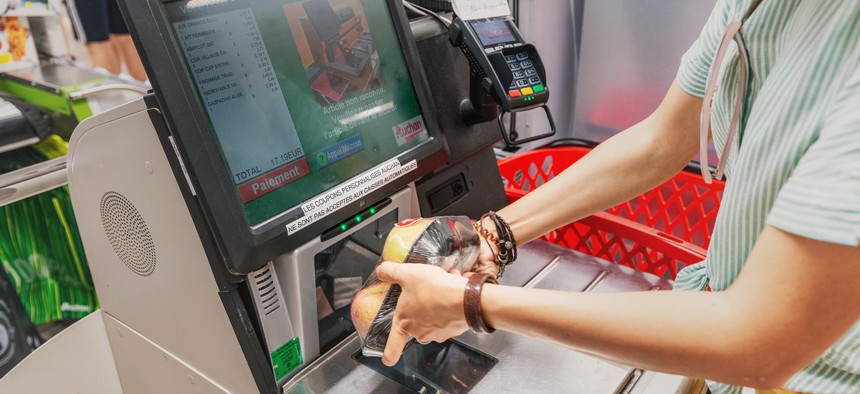TSA Wants Passenger Self-Screening that Looks Like Grocery Store Self-Checkout

frantic00/Shutterstock.com
The agency, in partnership with the Science and Technology Directorate, is planning a solicitation to streamline airport security without compromising safety.
Like self-checkout at grocery stores, airline passengers want to be able to move through security checkpoints at their own speeds through a passenger self-screening process, according to the Transportation Security Agency.
In a partnership between the Homeland Security Department’s Science and Technology Directorate and TSA, the agencies announced plans to issue a solicitation for passenger self-screening systems development in the near future.
The pending call for white papers is part of a larger broad agency announcement for Apex Screening at Speed, or SaS.
“The DHS S&T Screening at Speed program pursues transformative research and development activities that support a future vision for increasing aviation security effectiveness from curb to gate while dramatically reducing wait times and improving the passenger experience,” the notice on beta.SAM.gov states. “To enable this vision, SaS, in conjunction with TSA’s Innovation Task Force, is considering the development of a passenger self-screening solution to transform the TSA’s concept of operations.”
In order to be successful, the solution—incorporating new technology and processes—must be able to detect “weapons and organic threat items hidden on passengers without the same level of transportation security officer engagement normally present in the screening process.”
Overall, the program has five goals:
- Enable a self-sufficient experience in the passenger screening process.
- Allow for passenger on-person screening and divestment of personal property—for X-ray screening—to occur in a single step, compared to the two distinct steps that exist at airports today.
- Enable passengers to directly receive on-person alarm information while divesting, and allow for the passenger self-resolution of alarms through continued divestment to reduce instances where a pat-down/secondary screening procedure would be necessary.
- Allow passengers to complete the screening process more quickly.
- Maintain or improve the current security posture at the airport checkpoint.
The agencies plan to break the effort into three components: systems engineering and concept design resulting in blueprints for a working prototype; advancing existing hardware at low- to mid-level readiness to Technology Readiness Level 7 within one year; and advance low- to mid-level software to Technology Readiness Level 7 within one year.
“A successful solution would lead to a passenger friendly, intuitive screening process while improving security, accelerating passenger throughput, reducing pat-down rates, and reducing the overall level of contact a passenger experiences with other passengers and TSOs,” officials wrote.
The notice compares the desired experience to that of “self-checkout at grocery stores, self-tagging checked baggage or ATM machines.”
“This concept is initially targeted towards the TSA PreCheck environment, but as the capability matures it may be deployed as a part of a variety of security postures,” the notice states.
According to the pre-solicitation notice, the contract will be awarded through a full and open competition—no small business or other set-asides and the agencies do not plan to use governmentwide acquisition contracts or the General Services Administration’s schedules—with plans to award “multiple stand-alone contracts.”
TSA and S&T are not looking for proposals or additional information at this time, and do not want to receive any responses to the pre-solicitation notice. A full solicitation and request for white papers is expected sooner than later, as the agencies plan to make awards in late fiscal 2020 or early fiscal 2021.






